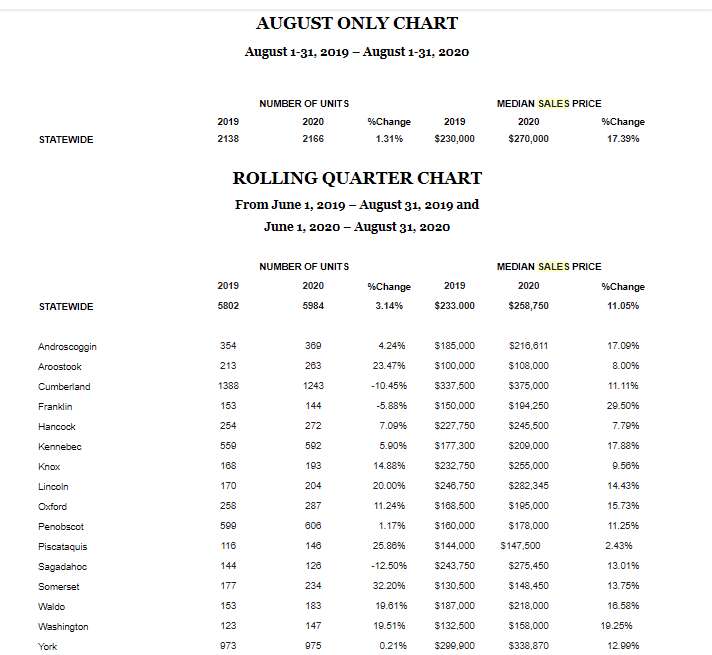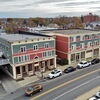
Maine home sales may beat 2019, driven by out-of-state buyers, low interest rates
More Information
Maine home sales are on a trend to beat last year's record, driven by an increase in out-of-state buyers and low interest rates.
Values of single-family existing homes in August were up 17.39% over last August. Sales are up 1.3% from the same month last year, despite months of uncertainty because of the pandemic.
While the market is being driven by low interest rates and out-of-state buyers, the price hike is driven by demand colliding with traditionally low inventory that's getting even more scarce, particularly in population centers.
"If it keeps trending the way it is, this could very well be our best year ever," Tom Cole, 2020 president of the Maine Association of Realtors, told Mainebiz Wednesday.
Sales from January through August are 0.7% off the pace of last year, which was a record year for sales and price. Some 18,140 single-family homes were sold in Maine in 2019, with a median sales price of $225,000.
The median sales price for an existing single-family home in Maine in August was $270,000, according to Maine Listings. The August 2019 median price was $230,000. Median sales price means that half of the homes sold for higher than that price, and half for less.
In August, home sales are up in the state 1.3% from last August, from 2,166 to 2,138.
The out-of-state buyer trend is real
While anecdotal tales of out-of-staters fleeing more urban areas have been circulating since early summer, it wasn't until July's numbers were in that there were data to back it up, Cole said.
While people could look all they wanted, they had to close on a sale before the anecdotes became reality, he said. "Looking at it month to month is a more realistic way to look at it," he said. "We didn't see significant figures until July."
In July, out-of-state sales were up 5.5% over July 2019; August showed a 9.7% increase over the previous year. Of the 2,166 single-family homes sold in August, 707 were bought by out-of-staters. Last year, 2,138 were sold in August, with 482 going to out-of-state buyers.
Cole said that while traditionally out-of-state buyers have bought vacation homes, camps and ski lodges, the new trend is single-family homes.
"What we're seeing is people are interested, they're looking, and they're making a choice to buy a home in Maine," he said.
Rural areas are now hot
Cole said there isn't one hot spot, or target area, for both out-of-state and in-state purchases, instead it's happening all over the state.
"It truly is a statewide increase," he said. "There's no special area" that's hotter than another.
Every county in the state showed a rise in home value over the last three months, with 12 of the state's 16 counties showing a percentage increase in double digits. All but three counties showed a rise in sales.
Cole said that the increase in sales in rural areas — Somerset County had a 32.2% increase for the June through August period this year compared to last — shows that as inventory in more populated parts of the state gets scarce, people are willing to venture to other areas.
In Somerset County 234 single-family homes were sold in the three-month period this year, as opposed to last year's 177. That was followed by Piscataquis County, which had a 25.86% increase, with 146 homes sold this year as opposed to last year. Aroostook County had a 23.47% increase, with 263 sales compared to last year's 213.
The biggest price increase in the three-month rolling quarter that ended in August was in Franklin County, where the median price was $194,250, compared to $150,000 for the same period last year.
Vital to the continued success is increased access to high-speed broadband across the state, which is a necessity for those moving from the state's population centers, as well as from out of state, who want to telecommute.
The Maine Association of Realtors supports initiatives that bring broadband access to more of the state, Cole said.
"If there isn't broadband for them, they're not going to move," he said.
The U.S. Bureau of Economic Analysis estimated that the real estate industry accounted for $12.2 billion in 2019, for 18% of Maine’s gross state product.
That's not only home sales, Cole said, but all the industries related to it, including home renovations.
The multiplier effect
"When someone buys a house, they have work done," he said, whether it's a kitchen overhaul, a new roof, painting or an addition. He said the strong real estate market has also supported contractors, home supply stores, lumber yards and more, both generally and during the pandemic.
Cole said that the state lost some contractors after the 2008 recession when new home construction slowed significantly in the state. The lack of inventory now, however, is boosting the industry.
"We need these people," he said. The economic activity in the real estate industry "is not just about sales, but about new construction, it's necessary and driving the economy for the state."
There is a historically low supply of homes for sale, 40% below a year ago, Cole said.
“The increased demand for the smaller supply of for-sale homes has created intense competition in some markets, leading to higher pricing,” says Cole. “As more for-sale inventory comes onto the market, we should see a balancing.”
Low interest rates a big factor
Demand is being fueled by all-time low mortgage interest rates, which means a more expensive home may now be attainable for some buyers, Cole said.
The difference between a 4.25% rate and a 3.25% can be the difference between someone buying a home or not.
"That increased affordability by 25%," he said. "It allows you to buy a home that you hadn't thought was affordable before."
He said that many apartment dwellers, particularly as rents in southern Maine rise, are realizing they can own a home with a mortgage that's not much different from what they were paying in rent.
The low inventory is one of the drivers in the rural sales increases.
Cumberland County, the state's most populous, showed a 10.25% drop in sales over June to August of last year, one of three counties in the state to show declines; the others are Franklin and Sagadahoc. Cole said that is partly an indication that as the Portland area's inventory gets lower, people are spreading out to other parts of the state.
Summer heats up
Cole said that no one five or six months ago would've predicted the current numbers. The 2020 uptick in sales — including a big increase in out-of-state buyers from last year — began in July, Cole said.
December, January and February were the strongest months ever for home sales in Maine, and all expectations were that 2020 would continue the trend. But, of course, no one counted on COVID-19. Sales started trending down, including a 15.41% decrease in April and 21.3% decrease in May compared to the same months in 2019, those prices continued to inch up. Things began recovering in June, when the decrease compared to June 2019 was just 4.3%.
The first increase since February was in July, when sales jumped 12.4% over the previous July.
"It looked like 2020 was going to be OK, but below 2019," be said, although there was apprehension. "No one really knew what was going to happen."
Maine is hotter than the national and regional trends, but they, too, show increases. The National Association of Realtors reported an 11% increase nationwide, with a median price of $315,000, which is an 11.7% increase. Regionally, sales in the Northeast increased 5.7%, while the regional MSP jumped 10.4% to $349,500.
Real estate brokers doing their thing
Cole said that in March and April, as the challenges of the pandemic became clear, real estate brokers were proactive in figuring out how to make things work. Not only adding virtual elements, but also focusing on using personal protective equipment and making sellers and buyers feel safe.
He said as time went on "people felt a little more comfortable."
Also, "People need to move," Cole said. "For whatever the reason, a new job, whatever it is. Regardless of what else is gong on, people need to move."
There's another time-honored reality as well, he said.
"A house is a home," he said. Real estate brokers are in the business of helping people make it happen. "It's really the major part of what we do, and it's nice helping people achieve that."










0 Comments